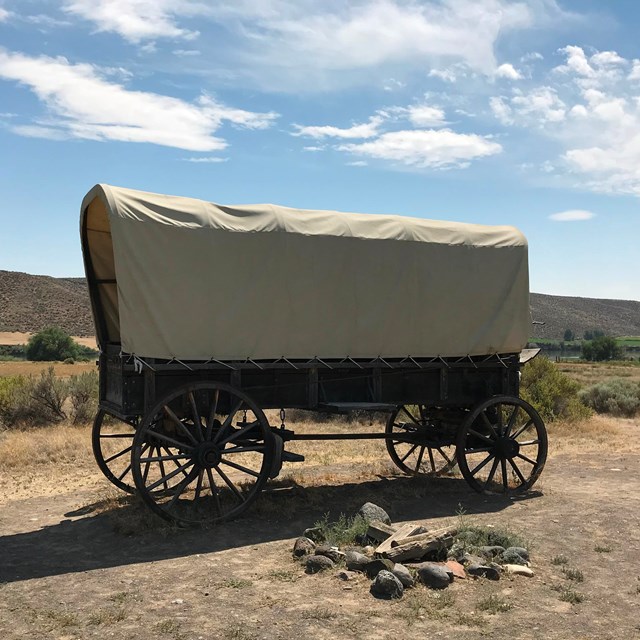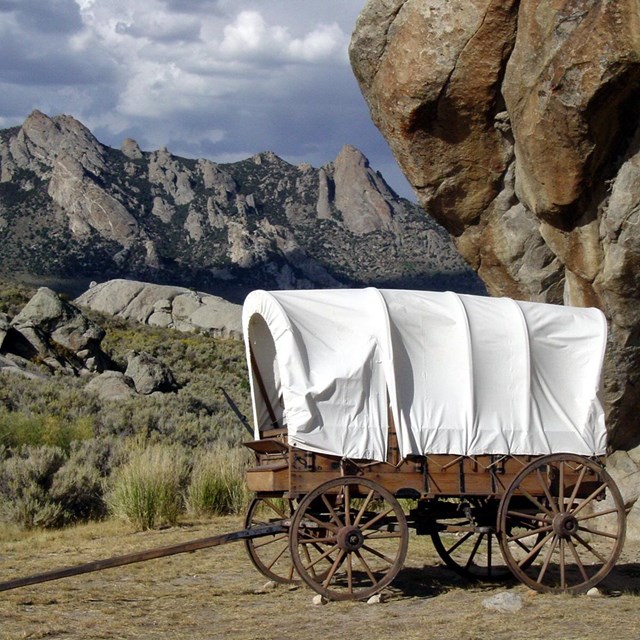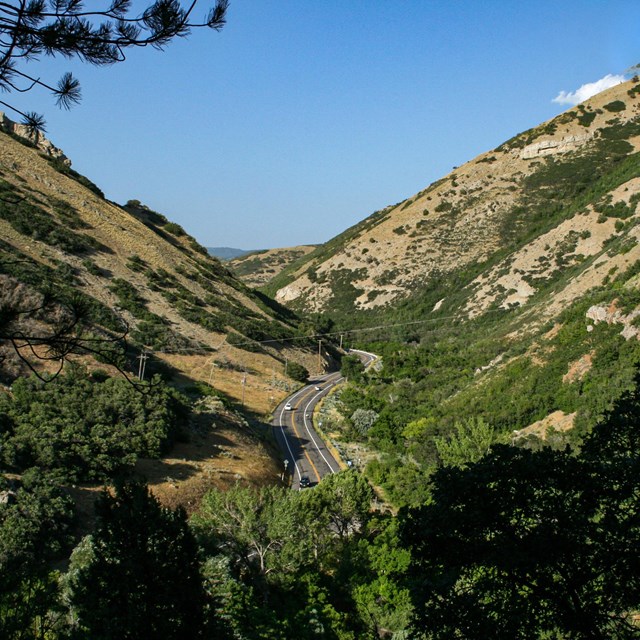Last updated: March 28, 2022
Article
Methodology - Sweet Freedom's Plains: African Americans on the Overland Trails 1841-1869
Sweet Freedom's Plains
African Americans on the Overland Trails 1841-1869
By Shirley Ann Wilson Moore, PhD.
For the National Park Service
National Trails Regions 6, 7, & 8
Introduction/Table of Contents
Methodologically, this work places African American emigrants, their experiences, and their self-perceptions at the center of the story of overland emigration. It attempts to understand what these overlanders valued as black people living in nineteenth century America, and what they expected of themselves and their new homes in the West. One reviewer observed a perceived imbalance in this report insofar as the majority of the stories and examples presented seem to illustrate the courage and perseverance of African American overlanders. Where, the reviewer wondered, are the stories of blacks who engaged in dishonest or shameful activities? After all, the history of overland migration abounds with tales of corrupt, treacherous, and violent whites who exploited emigrants. For example, the accounts of so-called “white Indians”—white men who disguised themselves as Indians and preyed upon emigrant wagon parties, then blended in with the white emigrants—occur throughout trails literature. Are there comparable tales about African Americans? This seeming “imbalance” is rooted in the inherent problems of doing the history of African American overlanders, not in any bias or desire to conceal the truth. Accounts about black emigrants’ activities, positive or otherwise, are scarce. Clearly, there were no “black Indians.” However, the stories (in Chapter 3) of George Berryman, the desperate slave of an unscrupulous black owner, the “runaway slave” and dubious “sheriff” who swindled a party of white emigrants in Texas, and “negro Andy” who participated in the rape of an Indian woman, show that some African Americans engaged in villainous activities on the trail. But accounts of black misdeeds are, like other stories of black overlanders, limited. Trails literature tends to disregard the activities of blacks. Most of the stories that exist are told by whites, some of whom were not exactly unbiased observers. In addition, black overlanders and their descendants would have been unlikely to write about or publically share stories of xii behavior that was less than admirable. This aspect of the African American overland experience perhaps is buried deep in the family lore of generations of black pioneer families. Mindful of these challenges, this report has attempted to retrieve the stories (whether laudable or disreputable) of the black men and women who traveled the overland trails, and place them firmly within the history of western emigration and settlement.
This report is indebted to and draws deeply from earlier scholarship on African Americans in the West. I have relied on Delilah Beasley’s pioneering Negro Trail Blazers of California for a wealth of detail about black western settlers. Beasley’s book is one of the earliest works to take a professional approach to the subject, even though she was a self-taught researcher and historian. The personal stories, manumission papers, and other primary sources included in her book have been invaluable. Other early scholarship of the black western experience that has been enormously helpful for my research include Kenneth Wiggins Porter’s edited volume, The Negro on the American Frontier, the works of W. Sherman Savage published in The Journal of Negro History, and the work of Sue Bailey Thurman.3
Since the 1970s, there has been a renewed interest in the West and African American western history that has produced an abundance of outstanding scholarship. This report has incorporated the pioneering works of Jack Forbes, William Loren Katz, Rudolph Lapp, James Fisher, and John W. Ravage for their rich research on the black experience in the West. Of course Quintard Taylor’s groundbreaking book, In Search of the Racial Frontier: African Americans in the American West, 1528-1990, has set a new standard for all scholars working in the field of African American western history. In addition, the works of John D. Unruh, Jr., Merrill J. Mattes, Dale L. Morgan, and William H. Leckie are touchstones in the field of western and overland trails scholarship. Richard V. Francaviglia’s remarkable book, Mapping and Imagination in the Great Basin: A Cartographic History, has added a new dimension to our understanding of the landscape and the geography of the American West.4 This work also incorporates diaries, journals, census records, maps, government documents, and other primary and secondary sources to tease the stories of African American emigrants from the general narrative of overland migration.
My effort to hear the voices of black emigrants has been an exhilarating and sometimes frustrating task. Contemporary white diarists and commentators (the most prolific chroniclers of the overland emigrations) tended to be racially condescending or dismissive of the African American presence. These sources can be tremendously useful but not necessarily representative of the realities of African Americans’ contributions to the overland emigration story. Because of the paucity of specific information on black overland emigrants, most of the words and descriptions of African Americans, by necessity, have come from white diarists and observers. Nevertheless, these sources, no matter how casual or disdainful the observation, indicate that African Americans were a key aspect of the overland migration. What emerges from the brief references to blacks in white accounts is a picture of black agency, capability, and purpose that most white contemporaries could not or would not acknowledge.
I have also drawn on oral histories, interviews, and reminiscences of black emigrants and their descendants for this report. I personally conducted interviews with emigrant descendants whom I identified during the course of my research. While oral history can pose problems for historical accuracy (e.g., memory dims with the passage of time, second-hand accounts can be unreliable, or the interviewee can have a selective memory), it is an invaluable tool for illuminating the personal, for gaining alternate perspectives, and for allowing the marginalized to enter the mainstream. Because many (if not most) black overlanders were illiterate, their only option was to transmit their stories and experiences orally. Their stories have been preserved and carried down through time as family lore. I have included oral histories in this study, fully aware of their inherent problems but convinced of their importance in gaining insight into what African American emigrants believed about themselves, unfiltered through the perceptions of whites. The descendants of African American pioneers, though removed in time from the actual events, are the living repositories of the experiences of black emigrants. My objective in using oral histories and recollections is, as nearly as possible, to let the black overlanders speak for themselves. In this way we can learn what they valued enough to preserve and pass along to succeeding generations.
Style and Format
In quoting from primary source documents I have chosen to retain the peculiarities of nineteenth-century spelling, grammar and word usage. Some documents contain words, phrases, and racial epithets that may be offensive to modern readers. In each case, the words or phrases are in quotation marks or block quotes; I have kept the original text and have not changed the wording. The citations used in this study (footnotes and bibliography) follow the Chicago style as outlined in the manual by Kate L. Turabian.5 The footnotes are done in the “complex notes” format shown in the Turabian manual. That is, to avoid cluttering the text with reference numbers when several sources are cited to make a single point, the cited sources are grouped into a single footnote. The citations in the footnote are listed in the same order that the references appear in the text. The listed citations in the footnote are separated by semicolons.6
3 Delilah Beasley, The Negro Trail Blazers of California (Los Angeles: University of California Press, 1919); Kenneth Wiggins Porter, ed., The Negro on the American Frontier (New York: Arno Press and the New York Times, 1971); W. Sherman Savage, “The Negro in the Westward Movement,” Journal of Negro History 24, no. 4 (October 1940): 531-539, and “The Negro in the History of the Pacific Northwest,” Journal of Negro History 13, no. 3 (July 1928): 255-264; and Sue Bailey Thurman, Pioneers of Negro Origin in California (1949; repr., San Francisco: A and E Research Associates, 1971).
4 Jack Forbes, African Americans in the Far West: A Handbook for Educators (Berkeley: Far West Laboratory for Educational Research and Development, 1970); William Loren Katz, The Black West: A Pictorial History, 3rd ed. (Seattle: Open Hand Publishing, 1987); Lapp, Blacks in Gold Rush California; James Fisher, “A History of the Political and Social Development of the Black Community in California, 1850-1950” (PhD diss., State University of New York, Stony Brook, 1971); John W. Ravage, Black Pioneers: Images of the Black Experiences on the North American Frontier (Salt Lake City: The University of Utah Press, 1997); Taylor, In Search of the Racial Frontier; see also Quintard Taylor and Shirley Ann Wilson Moore, African American Women Confront the West, 1600-2000 (Norman: University of Oklahoma Press, 2003); John D. Unruh, Jr., The Plains Across: The Overland Emigrants and the Trans-Mississippi West, 1840-60 (Urbana: University of Illinois Press, 1979); Merrill J. Mattes, Platte River Road Narratives: A Descriptive Bibliography of Travel Over the Great Central Overland Route to Oregon, California, Utah, Colorado, Montana and Other Western States and Territories, 1812-1866 (Urbana: University of Illinois Press, 1988); Dale L. Morgan, ed., Overland in 1846: Diaries and Letters of the California-Oregon Trail, vols. 1 and 2 (Lincoln: University of Nebraska Press, 1963); William H. Leckie and Shirley A. Leckie, The Buffalo Soldiers: A Narrative of the Black Cavalry in the West (Norman: University of Oklahoma Press, 2003); Richard V. Francaviglia, Mapping and Imagination in the Great Basin: A Cartographic History (Reno: University of Nevada Press, 2005).
5 Kate L. Turabian, A Manual for Writers of Research Papers, Theses, and Dissertations, 7th ed. (Chicago: University of Chicago Press, 2007).
6 For more on complex notes, see Ibid., 153




